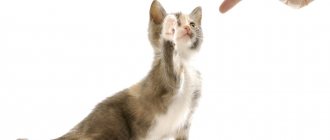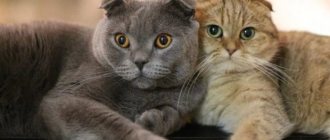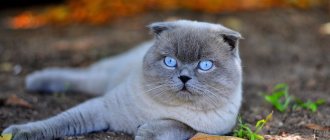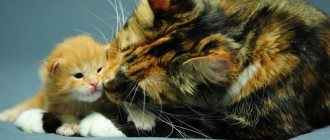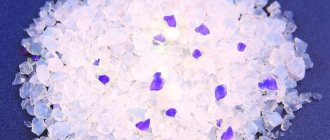A kitten is a full-fledged member of the family. Therefore, when getting a pet, you must not only prepare everything necessary for its happy life (more about this in the article “Caring for Scottish Folds”), but also decide why you are getting it. I would also advise that before buying a Scottish Fold kitten, choose its gender, color and desired character. Also, pay attention to the health and general appearance of your potential new “roommate.”
Target
If you have never visited or participated in a pet show, you have not even thought about its prospects . However, if you are lucky enough to purchase a Scottish Fold directly at an exhibition, the seller will advise you to take part in such an event at least once. And then, as the owners of such “show” pets usually tell me... Once I tried, I won or didn’t win, but I want to do it again! Exhibitions of elite animals are becoming not just a hobby for people, but a real addiction (of course, in the good sense of the word). Of course, you can exhibit the most ordinary cat of yard breeds, but, you see, it is unlikely to win recognition.
Some owners of Scottish Folds do not always want to show their pets in public - for them it is something personal.
Therefore, before you buy a cat, clearly define the purpose of your purchase, what fate you have prepared for your pet. Last but not least, this is important because by buying a kitten “for yourself” you can save on confirming the pedigree, whereas most elite exhibitions require a supporting document.
When is the best time to pick up a kitten from a breeder?
The smaller the kitten, the more affection it evokes; you want to quickly take possession of this little fluffy ball and become its only patron in the world. But we can't rush . An early separation from the mother will not benefit the baby; he still does not adapt well to space and is not confident in his abilities. The question arises: at what age can you take a kitten home? Breeders believe that the optimal period would be 3 months of age . Until this time, you can simply reserve the fluffy one and watch it grow from afar. During this time, the mother cat will teach him basic knowledge;
- Make sure he starts eating right;
- Will take care of his fur;
- Massage the tummy with your tongue, improving digestion;
- Instills the skills of going to the litter box and using a scratching post;
- Shows how to communicate with people and other animals.
If a baby is torn away from his parent ahead of time, this can affect his psyche, make him insecure and nervous, and affect his health. It is necessary to take into account that primary immunity received from a cat lasts no more than 6 weeks in a quarter of kittens. In this regard, any move at this time to a new place can cause stress and further weakening of the body's defenses .
You should not take your kitten home ahead of time because the first vaccination occurs in the 8th week of life , and the second one – after 4 weeks. During the vaccination period, the baby may feel some discomfort, and the presence of his mother nearby will calm him down, but after the 12th week the baby will be ready to withstand various viruses and can calmly change his environment.
If you want to buy a cheerful, healthy and mentally balanced pet, do not rush to pick it up from the breeder. Scots classification
On the Internet, purebred animals are divided into the following categories:
- Pets are typical representatives of the breed, not selected for breeding, but are good for home keeping as a simple family pet. The reason for the lack of demand among breeders is deviations from standard requirements. For example, “unauthorized” color, malocclusion, consequences of rickets. Animals in this category are cheaper than their more fortunate counterparts.
- Breed - animals that meet all the requirements of the breed, but no more, that is, without any pronounced features, traits that would make the individual particularly attractive for improving offspring. At exhibitions, such cats go unnoticed, one of many.
- Show - the most promising for breeding, regulars at exhibitions, collectors of medals and titles. Of the entire line of purebred animals, they are the most expensive and high-status .
In fact, this classification is conditional and a pet can become a breed individual or a cat with excellent external show data, but removed from breeding for some reason, for example:
- A genetic anomaly has manifested itself in one of the littermates, and there are suspicions that in the rest, the defect is dormant for the time being;
- One of the brothers or sisters easily entered the top of the cool breed animals, he will be exhibited at exhibitions as an exclusive specimen, the price of his offspring will rise. To maintain the cat's uniqueness, all other littermate competitors are discounted, although they may be no worse;
- A breeder may have a line of animals with exclusive data. In order to preserve this line only for ourselves, breeding is carried out only within the walls of this nursery, and the “surplus” is completely removed from breeding and sold to those who wish.
But this does not mean that such kittens cannot build a show career and win various titles and cups. Exhibitions are held for them in the castrati class.
A cat that falls into the show class category may not be the best among its peers. Experts in the rings evaluate the external characteristics, behavior, training, breed of an animal, but not its breeding qualities. A handsome man may be an average producer. If you want to become the owner of a show kitten, then you should opt for the fluffy one that has already received a positive assessment from an expert.
definitely value breed-class cats , that is, those animals that:
- They have excellent pedigrees;
- Passed all the necessary tests to identify dormant anomalies;
- They are carriers of excellent genetics;
- They can pass on the best traits of the breed to their offspring.
Novice breeders are most often unable to independently understand the qualities of a kitten intended for breeding. They are recommended several options:
- Buy a baby from a breeder you can trust;
- Seek advice from an expert;
- Take courses in felinology on your own and try your hand at practice.
Basic rules when choosing a kitten
When choosing a kitten, I advise you to first pay attention to its appearance . Thick, smooth and uniform coat without various spots indicates the health and thoroughbred of the baby. Eyes and ears must be clean. Take a closer look to see if there are any dried tears in or under your eyes, or if there are any visible damages.
Assess the overall activity and playfulness of the animal: the pet should be playful and radiate a love of life with its entire appearance
Of course, a healthy pet can be calm, but there should also be a twinkle in his eyes.
Buying a kitten “for ourselves”
At an early age (1-2 months), kittens look very cute, but bias when buying them can lead to the wrong choice. I advise you to put aside your emotions for a while and treat the purchase rationally.
As with pedigree Scottish Folds, the optimal age for purchase is four months . However, you can wait: up to nine months. During this period, the pet will enter adolescence. He will stretch out, become somewhat awkward and long-legged. Cats develop evenly, while in males this process is not entirely corrected. The ears may be too long, the body will become elongated, and the legs will remain short for a long time. But don’t panic: this goes away with age. As a rule, by the age of one year the body becomes proportional.
Here is a short list of what a healthy Scotsman under one year of age should look like:
- Big muzzle;
- Developed limbs;
- Small ears;
- Moderately thick and even tail;
- Short and thick coat.
What vaccinations are given to Scottish kittens?
The first vaccination for a Scottish kitten is done at the age of 2.5-3 months, 7-10 days after deworming and flea removal (the veterinarian must first examine the kitten, measure the temperature, the baby must be healthy!). The most commonly used vaccine is Nobivak Triket, which protects against major cat diseases.
A month later, a second vaccination with the same drug is prescribed, and now it is permissible to vaccinate against rabies. But the kitten’s body may not tolerate this vaccine, so if your kitten lives in an apartment, you don’t go anywhere, it’s better to vaccinate against rabies later (for example, at one year of age). In the future, vaccinations are done once a year. You can also get vaccinated against lichen, again, if the environment requires it.
Muzzle and ears
I devote a separate subsection to such an important part of the animal’s body as the head . Scottish Folds have very beautiful ears, so when choosing a pet, give preference to small and beautifully laid ears. If a Scotsman's ears are not drooping, and the seller convinces you that they will droop with age, do not believe it! In the article about the origins of the Scottish Fold, I already mentioned that whether a cat is folded or not is visible no later than the twenty-first day of birth. There are situations when the ears rise from the heat, but this happens quite rarely and is easily checked.
When choosing a cat, pay attention to its bite. Ideally, it is scissor-shaped. Check your teeth: are all the fangs in place, are there any cracks in the teeth. If you are buying a cat for an exhibition, it is better not to be too lazy to check this with a veterinarian, since at exhibitions separate points are awarded for dental health
The Scottish Fold's nose should be straight, without humps. Identifying unevenness is very simple - by running your finger from the earlobe to the forehead, you will definitely feel it. Perhaps this will not be visually noticeable, and therefore the hump will seem unimportant to you, but the descendants of such cats may have a long nose, which definitely complicates the sale of the offspring.
Where to buy a Scottish kitten
Scots are quite difficult to breed, so only professionals with extensive experience and a competent approach do this.
Breeders are especially careful about the careful selection of breeding Scots
Why is this so important? The fact is that with illiterate selection, the gene for lop-earedness, which dominates in Scots, can negatively affect the skeletal system of cats
The fact is that with illiterate selection, the lop-eared gene, which dominates in Scots, can negatively affect the skeletal system of cats.
To prevent this, felinologists select for breeding only those representatives who can give the offspring the maximum number of positive properties to their offspring.
On a note!
Russian and Ukrainian specialists were especially successful in breeding Scots. There are still few breeders of modern type Scots in Belarus due to their high cost. Therefore, this breed is most often imported.
But the Internet is full of advertisements for the sale of Scots without documents. And you must always remember that this is a huge risk. According to statistics, less than 1% of undocumented Scottish kittens have healthy genes and obvious breed characteristics.
Uncertified breeders may cheat by breeding old-type or even phenotypic cats with atypical fold ears. Since the lop ear gene is dominant, a person can take any cat with it and pass off the offspring as a Scottish Fold.
Meanwhile, a thoroughbred Scot is far from neat, droopy ears, but, first of all, a strict set of certain thoroughbred qualities, a pronounced breed type of character and physique.
Of course, the “substitution” would be quickly noticed at an exhibition or by an experienced breeder. But it will be extremely difficult for an inexperienced person to see the difference. In addition to behavior and character traits, there are certain physical signs by which you can see a low-quality “product”: disproportionate ears, incorrect placement of the ears, their loose fit to the head, raising of the ears as the kitten grows older.
Beginner or amateur breeders may make another common mistake: breeding Folds with Britons. However, for more than 10 years, felinologists have been strongly recommending for mating only a certain pair of Scottish Fold - Scottish Straight.
If you save $100-200 on buying a non-certified kitten, you risk getting more problems and disappointment from not matching the breed than joy.
Prices
Pedigree, pedigree, color, health and even gender directly affect the cost of Scottish Fold cats. It is very important to decide in advance whether to buy a pet in a nursery, on special websites or “from people”. The latter have the lowest prices. However, you should be careful here: if you are not provided with documents indicating the pedigree of the cat and kittens, then there is no guarantee that it is truly a Scottish Fold.
Prices “from people,” according to advertisements on the Internet, vary from 2,500 to 30,000 rubles . Also, the price can be negotiable, and mainly depends on whether you require a pedigree or not.
On shopping sites and in nurseries, prices can be much higher (about 40,000 rubles) , but there are much more guarantees.
Worms in Scottish kittens
If you notice that your kitten has become lethargic, does not want to eat, or, conversely, eats a lot, but is losing weight, with intestinal upset, bloating (and you are feeding correctly), and the kitten fidgeting on the floor on its butt, it is possible. worms (helminths) have appeared.
It is better to deworm a Scottish kitten in 2 stages with an interval of 2 weeks (suspensions, tablets, drops on the withers), with the exception of Profender drops on the withers due to the long period of action. I do not recommend using Prazitel, Prazicide, Drontal (they will most often be offered to you at the pharmacy from inexpensive drugs) due to the increasing frequency of counterfeits and bad reviews from cat owners.
Calculate the dosage strictly according to the kitten’s weight. If you can’t feed your pet a tablet, crushed and mixed with food, then you can use Canikquantel Plus, it is sold in the form of a gel. Give using a syringe without a needle into the corner of the mouth.
After deworming, it is better to give half a teaspoon of Enterosgel, diluted with water, or another sorbent. After the entire procedure, be sure to watch the kitten for the first few hours, it must go to the toilet.
Kittens need to be dewormed once every 3-5 months, especially if they eat raw meat. It is also necessary to undergo this procedure 7-10 days before vaccination!
